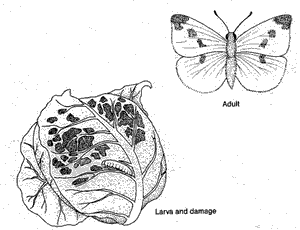 |
Also known as the cabbage worm and the European cabbage worm, the Imported Cabbageworm is a 1 1/4-inch light green caterpillar with one yellow stripe. It chews foliage, and produces soft green excrement. Its bullet-shaped whitish yellow eggs are laid singly on leaves. The adult is a white day-flying butterfly with three to four black spots on its wings. It over-winters as a pupa in the soil. Several generations occur each year. Imported cabbage worms are found throughout the United States.
When fully grown, the larva is about 1 inch in length and velvety green with a faint yellow stripe along the middle of the back and a row of yellow spots along each side. The larva crawls slowly over the plant and does not show any of the looping action characteristic of the cabbage looper, another important pest of cabbage. Another life stage of this insect that is commonly seen on cabbage plants is the pupal stage, which is a non-feeding stage just prior to the emergence of the butterfly. Pupae are about 4/5 inch long, sharply angled, and green spotted with black.
VULNERABLE PLANTS – These worms will work on the entire cabbage family but definitely prefer cabbage and cauliflower; also Alyssum and Nasturtium in the flower garden. They frequently damage turnips, kale, collards, radishes, and mustard.
Emergence Time - Imported cabbage worms overwinter in the ground as pupae, and emerge in late spring. There are usually four to six generations of imported cabbgeworms per year in the south and two or three in the north.

